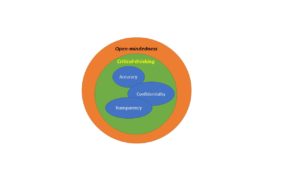SPOT: Our difficulties in stopping cyber-bad-guys

A perspective on where the cybersecurity challenge started
The world is run by ones and zeroes…There’s a war out there…It’s about who controls the information (Kaplan, 2016, p. 31).
Regular intrusions into the critical United States (U.S.) state and federal Information Technology (IT) systems highlight the ever agile and highly impactful effects of cyber-threats worldwide (Allyn, 2019; Olson, 2012; Starr, 2015; Stoll, 2005). The 2015 Office of Personnel Management (OPM) security breach was one of the most extensive and damaging exfiltrations of U.S. government personnel data in history (Koerner, 2016; Naylor, 2016).
Cyber-attacks have even adversely affected the supposedly highly protected networks of the Department of Defense (DOD). “For nearly a week, some 4,000-key military and civilian personnel working for the Joint Chiefs of Staff [had] lost access to their unclassified email after what is now believed to be an intrusion into the critical Pentagon server that handles that email network” (Starr, 2015, para. 3). The ability to better detect and prevent these cyber-assaults by nefarious threats has of yet not substantially improved (Allyn, 2019; Garamone, 2018; Stoll, 2005).
Cyber-thugs also repeatedly hack companies and agencies around the globe (Kaplan, 2016; Olson, 2012). Computer attacks happen to even the most technically savvy companies such as Eurofins, a United Kingdom’s (U.K.) based company in 2019 (Devlin, 2019; Olson, 2012). It paid an undisclosed amount of money to hackers to regain access to their databases’ and records’ repositories; this information was vital to Britain’s primary criminal forensics support firm to the multitude of the U.K.’s law enforcement agencies (Devlin, 2019). Global technically-capable organizations fail against ongoing cyber-assaults. Companies’ ability to detect and stop the effects of an active threat remains limited (Allyn, 2019; Olson, 2012; Garamone, 2018; Stoll, 2005).
Ezeife, Dong, and Aggarwal (2008) describe the frustration and level of effort needed to defend against cyber-intrusions. The requirements to monitor threats and update threat data sources, lists, and reports are labor-intensive activities (Darktrace, 2019c; Ezeife, Dong, & Aggarwal, 2008; Homeland Security Systems Engineering and Development Institute [HSSEDI], n.d.). These manual efforts focus on detecting– and not always preventing– a cyber-threat intrusion into an organization’s IT environment, i.e., network. Ezeife et al. (2008) further describe the need to maintain signature databases, used to identify threats, as requiring “a lot of human involvement” (p. 98). The need for more capable automated solutions is critical to any future success in this arena.
Additionally, the U.S.’s Defense Industrial Base (DIB) provides contract goods and services to the DOD. It faces the same issue of frequent cyber-assaults against their corporate IT infrastructures (Garamone, 2018; Hensel, 2016). DIB companies must balance national security protection requirements with their financial stability and the knowledge that they, too, are valuable targets to the enemy (Hensel, 2016). These businesses face growing federal regulatory demands to protect critical DOD-provided information and to comply with federal cybersecurity rules and regulations (National Institute of Standards and Technology [NIST], 2015; 2018).
Federally-driven requirements are often cumbersome and add to the stress of protecting vital IT assets and capabilities (Ezeife et al., 2008; NIST, 2015; 2018). Organizations must secure their sensitive networks and data from cyber-threat nation-state actors engaged in cyberespionage. China, Russia, Iran, and North Korea are recognized as significant threats focused against the U.S (Clarke & Knacke, 2014; Mandiant, 2013; Olson, 2012; Starr, 2015). These threats are continually seeking insight into DOD and federal intentions against their respective countries (Garamone, 2018; Hensel, 2016; Starks, 2019). Success against these nation-state actors poses a significant concern to not only the DOD but the global community as well (Clarke & Knacke, 2014; Olson, 2012; Starr, 2015).
With the emergence of the Cybersecurity Maturity Model Certification (CMMC) , do we have a pathway forward?
Selected References
Allyn, B. (2019, August 20). 22 Texas towns hit with ransomware attack in ‘new front’ of cyberassault. National Public Radio. Retrieved from https://www.npr.org/2019/08/20/752695554/23-texas-towns-hit-with-ransomware-attack-in-new-front-of-cyberassault
Anitha, P., & Patil, M. M. (2018). A review of data analytics for supply chain management: A case study. International Journal of Information Engineering and Electronic Business, 10(5), 30–39. Retrieved from http://franklin.captechu.edu:2123/10.5815/ijieeb.2018.05.05
Basam, D., Ransbottom, J. S., Marchany, R., & Tront, J. G. (2016). Strengthening MT6D defenses with LXC-based honeypot capabilities. Journal of Electrical and Computer Engineering. Retrieved from doi:http://franklin.captechu.edu:2123/10.1155/2016/5212314
Chimento Jr, J. J. (2019). Toward an Understanding of Using High Entropic Digital Communication Techniques in Cybersecurity Decision Making (Doctoral dissertation). Retrieved from ProQuest Dissertations and Theses database. (UMI No. 13897847)
Chesney, R. (2015, October 13). Cybersecurity in 1989: Looking back at Cliff Stoll’s classic The Cuckoo’s Egg [Blog post]. Lawfare. Retrieved from https://www.lawfareblog.com/cybersecurity-1989-looking-back-cliff-stolls-classic-cuckoos-egg
Cisco. (2019). Artificial intelligence/machine learning for intent-based networking – primer [White paper]. Cisco. Retrieved from https://www.cisco.com/c/en/us/solutions/collateral/enterprise-networks/digital-network-architecture/nb-06-cisco-dna-ai-ml-primer-cte-en.pdf
Clarke, R. A., & Knake, R. K. (2014). Cyber war. New York, NY: Harper Collins.
Columbus, L. (2019a, June 16). Top 10 cybersecurity companies to watch in 2019. Forbes. Retrieved from https://www.forbes.com/sites/louiscolumbus/2019/06/16/top-10-cybersecurity-companies-to-watch-in-2019/#4b683b696022
Columbus, L. (2019b, May 27). 25 machine learning startups to watch in 2019. Forbes. Retrieved from https://www.forbes.com/sites/louiscolumbus/2019/05/27/25-machine-learning-startups-to-watch-in-2019/#181be6483c0b
Columbus, L. (2019c, January 23). Data scientist leads 50 best jobs in America for 2019 according to Glassdoor. Forbes. Retrieved from https://www.forbes.com/sites/louiscolumbus/2019/01/23/data-scientist-leads-50-best-jobs-in-america-for-2019-according-to-glassdoor/#457226e77474
Committee on National Security Systems. (2015, April 6). CNSS glossary. CNSS. Retrieved from https://rmf.org/wp-content/uploads/2017/10/CNSSI-4009.pdf
Corrigan, J. (2019, September 4). Pentagon, NSA laying groundwork for AI-powered cyber defenses. Nextgov. Retrieved from https://www.nextgov.com/cybersecurity/2019/09/pentagon-nsa-laying-groundwork-ai-powered-cyber-defenses/159649/
Cybersecurity and Infrastructure Security Agency Act of 2018, Pub. L. 115-278, 132 Stat. 4186, codified as amended at 6 U.S.C. §§651–674.
Davis, B., Whitfield, C., & Anwar, M. (2018, August). Ethical and Privacy Considerations in Cybersecurity. In 2018 16th Annual Conference on Privacy, Security and Trust (PST) (pp. 1–2). IEEE. doi:10.1109/PST.2018.8514188
Denning, D. (2017, August 18). Tracing the sources of today’s Russian cyberthreat. Scientific America. Retrieved from https://www.scientificamerican.com/article/tracing-the-sources-of-today-rsquo-s-russian-cyberthreat/
Department of Justice. (n.d.). Privacy act of 1974. DOJ. Retrieved from https://www.justice.gov/opcl/privacy-act-1974
Devlin, H. (2019, July 5). Hacked forensic firm pays ransom after malware attack. The Guardian. Retrieved from https://www.theguardian.com/science/2019/jul/05/eurofins-ransomware-attack-hacked-forensic-provider-pays-ransom
Digital.com. (n.d.). The deep web and dark web [Blog post]. Digital.com. Retrieved from https://digital.com/blog/deep-dark-web/
Director of National Intelligence. (2018, October). 2018 Information Sharing Environment. DNI. Retrieved from https://www.dni.gov/files/documents/FOIA/2018_Information_Sharing_Environment_Annual_Report.pdf
Djekic, M. (2019, July 5). Cyber security analytic purposes [Blog post]. Cyber Defense Magazine. Retrieved from https://www.cyberdefensemagazine.com/cyber-security-analytics-purposes/
Elder, J. (2013, June). It is a mistake to…lack relevant data [White paper]. Charlottesville, VA: Elder Research.
European Union (E.U.). (n.d.). GDPR key changes. EU. Retrieved from https://eugdpr.org/the-regulation/
Ezeife, C. I., Dong, J., & Aggarwal, A. K. (2008). SensorWebIDS: A web mining intrusion detection system. International Journal of Web Information Systems, 4(1), 97–120. Retrieved from http://franklin.captechu.edu:2123/10.1108/17440080810865648
Fang, X., Xu, M., Xu, S., & Zhao, P. (2019). A deep learning framework for predicting cyber attacks rates. EURASIP Journal on Information Security, 2019(1), 1–11. Retrieved from http://franklin.captechu.edu:2123/10.1186/s13635-019-0090-6
Funke, D., & Benkleman, S. (2019, May 23). How Russia’s disinformation strategy is evolving. Poynter. Retrieved from https://www.poynter.org/fact-checking/2019/how-russias-disinformation-strategy-is-evolving/
Garamone, J. (2018, February 13). Cyber tops list of threats to U.S. director of national intelligence says. Defense.gov. Retrieved from https://www.defense.gov/Newsroom/News/Article/Article/1440838/cyber-tops-list-of-threats-to-us-director-of-national-intelligence-says/
Guccione, D. (2019, July 4). What is the dark web? How to access it and what you’ll find. CSO Online. Retrieved from https://www.csoonline.com/article/3249765/what-is-the-dark-web-how-to-access-it-and-what-youll-find.html
Gupta, D. (2017, May 21). 25 must know terms & concepts for beginners in deep learning [Blog post]. Analytics Vidhya. Retrieved from https://www.analyticsvidhya.com/blog/2017/05/25-must-know-terms-concepts-for-beginners-in-deep-learning/
Gupta,
D., & Rani, R. (2018). A study of big data evolution and research
challenges. Journal of
Information Science, 1–19. Retrieved from https://doi.org/10.1177/0165551518789880
Gwynne, P. (2013). Predicting the progress of technology. Research Technology Management, 56(4), 2–3. Retrieved from https://franklin.captechu.edu:2074/docview/1458287915?accountid=44888
Hair, Joe F., Jr. (2007). Knowledge creation in marketing: The role of predictive analytics. European Business Review, 19(4), 303–315. Retrieved from doi:http://franklin.captechu.edu:2123/10.1108/09555340710760134
Halladay, S. D. (2013). Using predictive analytics to improve decisionmaking. The Journal of Equipment Lease Financing (Online), 31(2), 1–6. Retrieved from https://franklin.captechu.edu:2074/docview/1413251757?accountid=44888
Harvard Business Review (HBR). (2018). Artificial intelligence and machine learning driving tangible value for business [Briefing paper].
Hayden, L. (2010). IT security metrics: A practical framework for measuring security & protecting data. New York: McGraw Hill.
Hensel, N. (2016). The defense industry: Tradeoffs between fiscal constraints and national security challenges. Business Economics, 51(2), 111–122. Retrieved from http://franklin.captechu.edu:2123/10.1057/be.2016.16
Hubbard, D. (2009a, February 11). I am concerned about the CI, median and normal distribution [Blog post]. Hubbard Decision Research. Retrieved from https://hubbardresearch.com/i-am-concerned-about-the-ci-median-and-normal-distribution/
Hubbard, D. (2009b). The failure of risk management: Why it’s broken and how to fix it. Hoboken, NJ: John Wiley & Sons.
Hubbard, D., & Seiersen, R. (2016). How to measure anything in cybersecurity risk. Hoboken, NJ: John Wiley & Sons.
Jahan, A., & Alam, M. A. (2017). Intrusion detection systems based on artificial intelligence. International Journal of Advanced Research in Computer Science, 8(5) Retrieved from https://franklin.captechu.edu:2074/docview/1912629399?accountid=44888
Jasim, Y. A. (2018). Improving intrusion detection systems using artificial neural networks. ADCAIJ: Advances in Distributed Computing and Artificial Intelligence Journal, 7(1), 49–65. Retrieved from http://franklin.captechu.edu:2123/10.14201/ADCAIJ2018714965
Johns, A. (n.d.). What is internal data? – Definition & sources [Blog post]. Study.com. Retrieved from https://study.com/academy/lesson/what-is-internal-data-definition-sources.html
K, P. C., & Shivakumar, B. L. (2014). A review of trends and technologies in business analytics. International Journal of Advanced Research in Computer Science, 5(8), 225–229. Retrieved from https://franklin.captechu.edu:2074/docview/1658426584?accountid=44888
Kaplan, F. (2016). Dark territory: The secret history of cyber war. New York, NY: Simon & Schuster.
Koerner, B. (2016, October 23). Inside the cyberattack that shocked the US government. Wired. Retrieved from https://www.wired.com/2016/10/inside-cyberattack-shocked-us-government/
Kulp, P. (2019). Active cyber defense: A case study on responses to cyberattacks (Doctoral dissertation). Available from ProQuest Dissertations & Theses Global. (2247845452). Retrieved from https://franklin.captechu.edu:2074/docview/2247845452?accountid=44888
Kumar, P., & Verma, R. S. (2017). A review on recent advances & future trends of security in honeypot. International Journal of Advanced Research in Computer Science, 8(3). Retrieved from https://franklin.captechu.edu:2074/docview/1901458306?accountid=44888
Lau, C.H. (2019, January 10). 5 steps of a data science project lifecycle. Towards Data Science. Retrieved from https://towardsdatascience.com/5-steps-of-a-data-science-project-lifecycle-26c50372b492
Lee, A. J. (2015). Predictive analytics: The new tool to combat fraud, waste and abuse. The Journal of Government Financial Management, 64(2), 12–16. Retrieved from https://franklin.captechu.edu:2074/docview/1711620017?accountid=44888
Levy, N. (2019, July 26). Amazon R&D and infrastructure spending spike as tech giant staffs up on talent. GeekWire. Retrieved from https://www.geekwire.com/2019/amazon-rd-infrastructure-spending-spikes-tech-giant-staffs-technical-talent/
Lis, P., & Mendel, J. (2019). Cyberattacks on critical infrastructure: An economic perspective 1. Economics and Business Review, 5(2), 24–47. Retrieved from doi:http://franklin.captechu.edu:2123/10.18559/ebr.2019.2.2
Lyngaas, S. (2019, April 23). Someone is spoofing big bank IP addresses-possibly to embarrass security vendors. Cyberscoop. Retrieved from https://www.cyberscoop.com/spoofed-bank-ip-address-greynoise-andrew-morris-bank-of-america/
Maloney, D. (2017, October 19). Books you should read: The cuckoo’s egg. Hackaday. Retrieved from https://hackaday.com/2017/10/19/books-you-should-read-the-cuckoos-egg/
Mandiant. (2013, February 18). APT1: Exposing one of china’s cyber espionage units. Fireeye. Retrieved from https://www.fireeye.com/content/dam/fireeye-www/services/pdfs/mandiant-apt1-report.pdf
McGibony. (2015, June 30). Be a data detective [White paper]. Charlottesville, VA: Elder Research.
Mitchell, B. (2019, October 7). Computer ports: Usage & role in networking: Discover the wide range of computer connections. Lifewire. Retrieved from https://www.lifewire.com/computer-port-usage-817366
Nagrecha, S., & Chawla, N. V. (2016). Quantifying decision making for data science: From data acquisition to modeling. EPJ Data Science, 5(1), 1–16. Retrieved from doi:http://franklin.captechu.edu:2123/10.1140/epjds/s13688-016-0089-x
National Commission on Terrorist Attacks upon the United States. (2004). The 9/11 Commission report: Final report of the National Commission on Terrorist Attacks upon the United States. Authorized ed., 1st ed. New York: Norton.
National Association of State Chief Information Officers. (2016). Advanced cyber analytics: Risk intelligence for state government. NASCIO. Retrieved from https://www.nascio.org/Portals/0/Publications/Documents/2016/NASCIO_AdvancedCyberAnalytics_FINAL_4.18.16.pdf
National Institute of Standards and Technology. (2018, June 7). Protecting Controlled Unclassified Information in Nonfederal Systems and Organizations. NIST. Retrieved from https://csrc.nist.gov/publications/detail/sp/800-171/rev-1/final
National Institute of Standards and Technology. (2015, January 22). Security and Privacy Controls for Federal Information Systems and Organizations. NIST. Retrieved from https://csrc.nist.gov/publications/detail/sp/800-53/rev-4/final
Naylor, B. (2016, June 6). One year after OPM data breach, what has the government learned? National Public Radio. Retrieved from https://www.npr.org/sections/alltechconsidered/2016/06/06/480968999/one-year-after-opm-data-breach-what-has-the-government-learned
Olson, P. (2012). We are anonymous: Inside the hacker world of LulzSec, Anonymous, and the global cyber insurgency. New York, NY: Little, Brown, and Company.
Oltramari, A., & Kott, A. (2018). Towards a reconceptualisation of cyber risk: An empirical and ontological study. Journal of Information Warfare, 17(1), 4–73. Retrieved from https://franklin.captechu.edu:2074/docview/2059071274?accountid=44888
Orgera, S. (2019, August 5). How to use TOR browser for anonymous web browsing. Lifewire. Retrieved from https://www.lifewire.com/tor-browser-tutorial-4103599
Paliwal, D., Vaya, D., Khandelwal, S. (2013). Mathematical analysis of problem statements: Artificial intelligence. International Journal of Advanced Research in Computer Science, 4(3). Retrieved from https://franklin.captechu.edu:2074/docview/1443744864?accountid=44888
Palo Alto. (n.d.). What is an endpoint [Blog post]? Palo Alto. Retrieved from https://www.paloaltonetworks.com/cyberpedia/what-is-an-endpoint
Pham, T. M. (2018). Exploring strategies for incorporating population-level external information in multiple imputation of missing data (Doctoral dissertation). Retrieved from EBSCO Open Dissertations. http://search.ebscohost.com/login.aspx?direct=true&db=ddu&AN=788945D34A68B6CD&site=ehost-live
Prusak, L. (2010, October 7). What can’t be measured. Harvard Business Review. Retrieved from https://hbr.org/2010/10/what-cant-be-measured
Radziwill, N. M., & Benton, M. C. (2017). Cybersecurity cost of quality: Managing the costs of cybersecurity risk management. ArXiv. Retrieved from https://arxiv.org/ftp/arxiv/papers/1707/1707.02653.pdf
Rashid, T. (2016). Make your own neural network. Amazon Digital Services, LLC: Tariq Rashid.
Riemer, K., & Seidel, S. (2013). Design and design research as contextual practice [Editorial]. Information Systems and eBusiness Management, 11(3), 331–334. Retrieved from doi:http://franklin.captechu.edu:2123/10.1007/s10257-013-0223-2
Rodriguez, L., & Da Cunha, C. (2018). Impacts of big data analytics and absorptive capacity on sustainable supply chain innovation: A conceptual framework. LogForum, 14(2), 151–161. Retrieved from doi:http://franklin.captechu.edu:2123/10.17270/J.LOG.267
RSA. (2016, February 5). The role of TOR in cybercrime [Blog post]. RSA. Retrieved from https://www.rsa.com/en-us/blog/2016-02/role-tor-cybercrime
Russo, M. (2019). Critiques paper: Cybersecurity and data science join forces. Unpublished manuscript.
Russo, M. (2018). The Risk Reporting Matrix is a Threat to Advancing the Principle of Risk Management. Unpublished manuscript.
Schroer, A. (2019, April 10). 25 Companies merging AI and cybersecurity to keep us safe and sound. Built-In. Retrieved from https://builtin.com/artificial-intelligence/artificial-intelligence-cybersecurity
Schuchman, S. (2019a, May 12). History of the first AI winter. Toward Data Science. Retrieved from https://towardsdatascience.com/history-of-the-first-ai-winter-6f8c2186f80b
Schuchman, S. (2019b, May 12). History of the second AI winter. Toward Data Science. Retrieved from https://towardsdatascience.com/history-of-the-second-ai-winter-406f18789d45
Shaikh, F. (2016, October 3). Deep learning guide: Introduction to implementing neural networks using TensorFlow in Python. Analytics Vidhya. Retrieved from https://www.analyticsvidhya.com/blog/2016/10/an-introduction-to-implementing-neural-networks-using-tensorflow/
Shankland, S. (2019, October 25). Google’s quantum supremacy is only a first taste of computing revolution. Cnet. Retrieved from https://www.cnet.com/news/google-quantum-supremacy-only-first-taste-of-computing-revolution/
Sheu, K. (2019, April 30). Why network metadata is just right for your data lake [Blog post]. Vectra AI. Retrieved from https://www.vectra.ai/blogpost/why-network-metadata-is-just-right-for-your-data-lake
Siegel, E. (2016). Predictive analytics: The power to predict who will click, buy, lie, or die. Hoboken, NJ: John Wiley & Sons.
Silver, N. (2012). The signal and the noise: Why so many predictions fail–but some don’t. New York, NY: Penguin.
Soni, S., & Vyas, O. P. (2010). Using associative classifiers for predictive analysis in health care data mining. International Journal of Computer Applications, 4(5), 33–37. Retrieved from http://citeseerx.ist.psu.edu/viewdoc/download?doi=10.1.1.206.4564&rep=rep1&type=pdf
Somers, M. J., & Casal, J. C. (2009). Using artificial neural networks to model nonlinearity: The case of the job satisfaction–job performance relationship. Organizational Research Methods, 12(3), 403–417. Retrieved from https://doi.org/10.1177/1094428107309326
Starks, T. (2019, July 9). Cyber incidents were expensive in 2018. Politico. Retrieved from https://www.politico.com/newsletters/morning-cybersecurity/2019/07/09/cyber-incidents-were-expensive-in-2018-675243
Starr, B. (2015, July 31). Military still dealing with cyberattack ‘mess.’ CNN. Retrieved from https://www.cnn.com/2015/07/31/politics/defense-department-computer-intrusion-email-server/index.html
Stoll, C. (2005). The cuckoo’s egg: Tracking a spy through the maze of computer espionage. New York, NY: Simon and Schuster.
Stoll, C. (1988, May). Stalking the wily hacker. Communication of the ACM, 31(5), 484–497. Retrieved from http://mars.umhb.edu/~wgt/cisc4370/wilyhacker.pdf
Strand, M., Wangler, B., & Niklasson, M. (2004). External data incorporation into data warehouses: an exploratory study of identification and usage practices in banking organizations. In Proceedings of the CAiSE Forum at the 16th International Conference on Advanced Information Systems Engineering (CAiSE’04) (pp. 103–112). Retrieved from http://citeseerx.ist.psu.edu/viewdoc/download?doi=10.1.1.99.8300&rep=rep1&type=pdf
Tadjdeh, Y. (2019, September 6). Defense logistics agency embraces AI. National Defense. Retrieved from https://www.nationaldefensemagazine.org/articles/2019/9/6/defense-logistics-agency-embraces-ai
Taylor, M. (2017). Neural network math: A visual introduction for beginners. Vancouver, Canada: Blue Windmill Media.
Taylor-Sakyi, K. K. (2016). Big data: Understanding big data. arXiv. Retrieved from https://arxiv.org/ftp/arxiv/papers/1601/1601.04602.pdf
Tetlock, P. E., & Gardner, D. (2015). Superforecasting: The art and science of prediction. New York, NY: Crown Publishers.
Thurber, M. (2018, April 6). What is data wrangling and why does it take so long [Blog post]. Elder Research. Retrieved from https://www.elderresearch.com/blog/what-is-data-wrangling
Toth, E. (2017, December 21). Which are the most scanned ports [Blog post]? Bitninja. Retrieved from https://bitninja.io/blog/2017/12/21/port-scanning-which-are-most-scanned-ports
Trullen, J., & Bartunek, J. M. (2007). What a design approach offers to organization development. The Journal of Applied Behavioral Science, 43(1), 23–40. Retrieved from https://franklin.captechu.edu:2074/docview/236352484?accountid=44888
Udemy. (n.d.). Machine learning: Build neural networks in 77 lines of code. Retrieved from https://www.udemy.com/machine-learning-build-a-neural-network-in-77-lines-of-code/learn/lecture/13179726#overview
Under Secretary of Defense for Acquisition, Technology, and Logistics. (2006, August). Risk management guide for DOD acquisition. Retrieved from https://www.acq.osd.mil/damir/documents/DAES_2006_RISK_GUIDE.pdf
United States Health and Human Services. (n.d.). Health information privacy. HHS. Retrieved from https://www.hhs.gov/hipaa/index.html
University of Melbourne. (2018, May). Risk assessment methodology. Retrieved from https://safety.unimelb.edu.au/__data/assets/pdf_file/0007/1716712/health-and-safety-risk-assessment-methodology.pdf
van Veen, F. (2016). A mostly complete chart of neural networks. Asimov Institute. Retrieved from https://www.asimovinstitute.org/wp-content/uploads/2016/09/neuralnetworks.png
Vectra AI. (2019). The data science behind Cognito AI threat detection models [White paper]. Vectra AI. Retrieved from https://www.vectra.ai/download/the-data-science-behind-cognito-ai-threat-detection-models
Waddell, D. (2015, May 14). Global information security workforce study [Press release]. ISC2. Retrieved from https://www.isc2.org/-/media/ B7E003F79E1D4043A0E74A57D5B6F33E.ashx
Walsh, K. (n.d.). Audit log best practices for information security [Blog post]. Reciprocity. Retrieved from https://reciprocitylabs.com/audit-log-best-practices-for-information-security/
Walters, T. (n.d.). Incorporating external data into the data warehouse. SAS. Retrieved from https://support.sas.com/resources/papers/proceedings/proceedings/sugi22/DATAWARE/PAPER116.PDF
Warwick, K. (2010). Cultured neural networks. Proceedings of the Institution of Mechanical Engineers, Part I: Journal of Systems and Control Engineering, 224(2), 109–111. Retrieved from https://doi.org/10.1243/09596518JSCE916
Waterman, S. (2017, November 15). Experts say government’s information sharing program is all take and no give. Cyberscoop. Retrieved from https://www.cyberscoop.com/dhs-ais-program-house-homeland-committee/
Watkins, L. A., & Hurley, J. S. (2015). Cyber maturity as measured by scientific-based risk metrics. Journal of Information Warfare, 14(3), 57–65. Retrieved from https://franklin.captechu.edu:2074/docview/1967314091?accountid=44888
Weng, B. (2017). Application of machine learning techniques for stock market prediction (Doctoral dissertation). Retrieved from EBSCO Open Dissertations. http://search.ebscohost.com/login.aspx?direct=true&db=ddu&AN=DE0B8B4C2E217AE3&site=ehost-live
Wilner, A. S. (2018). Cybersecurity and its discontents: Artificial intelligence, the Internet of Things, and digital misinformation. International Journal, 73(2), 308–316. Retrieved from https://doi.org/10.1177/0020702018782496
Wilson, H.J., & Daugherty, P.R. (2018, July-August). Collaborative intelligence: Humans and AI are joining forces. HBR. Retrieved from https://hbr.org/2018/07/collaborative-intelligence-humans-and-ai-are-joining-forces
Yu-Zhong, C., Zi-Gang Huang, Xu, S., & Ying-Cheng, L. (2015). Spatiotemporal patterns and predictability of cyberattacks. PLoS One, 10(5). Retrieved from https://franklin.captechu.edu:2074/docview/1685181563?accountid=44888
Zhan, Z., Xu, M., & Xu, S. (2013). Characterizing honeypot-captured cyber attacks: Statistical framework and case study. IEEE Transactions on Information Forensics and Security, 8(11), pp.1775–1789. doi: 10.1109/TIFS.2013.2279800
Zuech, R., Khoshgoftaar, T. M., & Wald, R. (2015). Intrusion detection and big heterogeneous data: A survey. Journal of Big Data, 2(1), 1–41. Retrieved from http://franklin.captechu.edu:2123/10.1186/s40537-015-0013-4

Dr. Russo is currently the Senior Data Scientist with Cybersenetinel AI in Washington, DC. He is a former Senior Information Security Engineer within the Department of Defense’s (DOD) F-35 Joint Strike Fighter program. He has an extensive background in cybersecurity and is an expert in the Risk Management Framework (RMF) and DOD Instruction 8510, which implement RMF throughout the DOD and the federal government. He holds a Certified Information Systems Security Professional (CISSP) certification and a CISSP in information security architecture (ISSAP). He has a 2017 Chief Information Security Officer (CISO) certification from the National Defense University, Washington, DC. Dr. Russo retired from the US Army Reserves in 2012 as a Senior Intelligence Officer.









